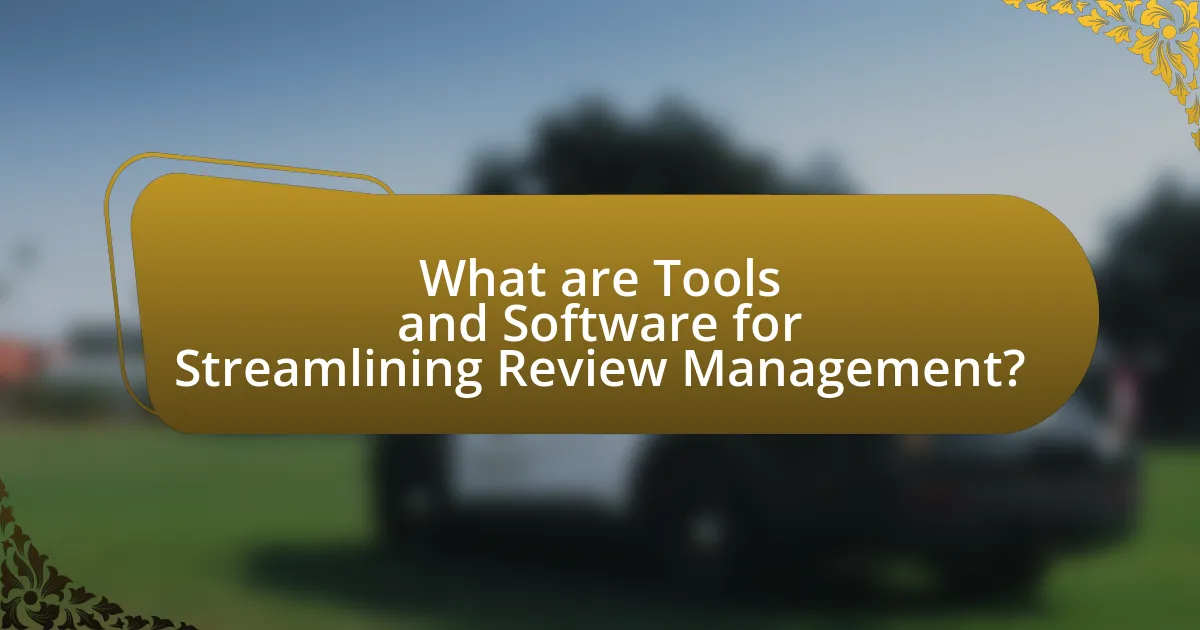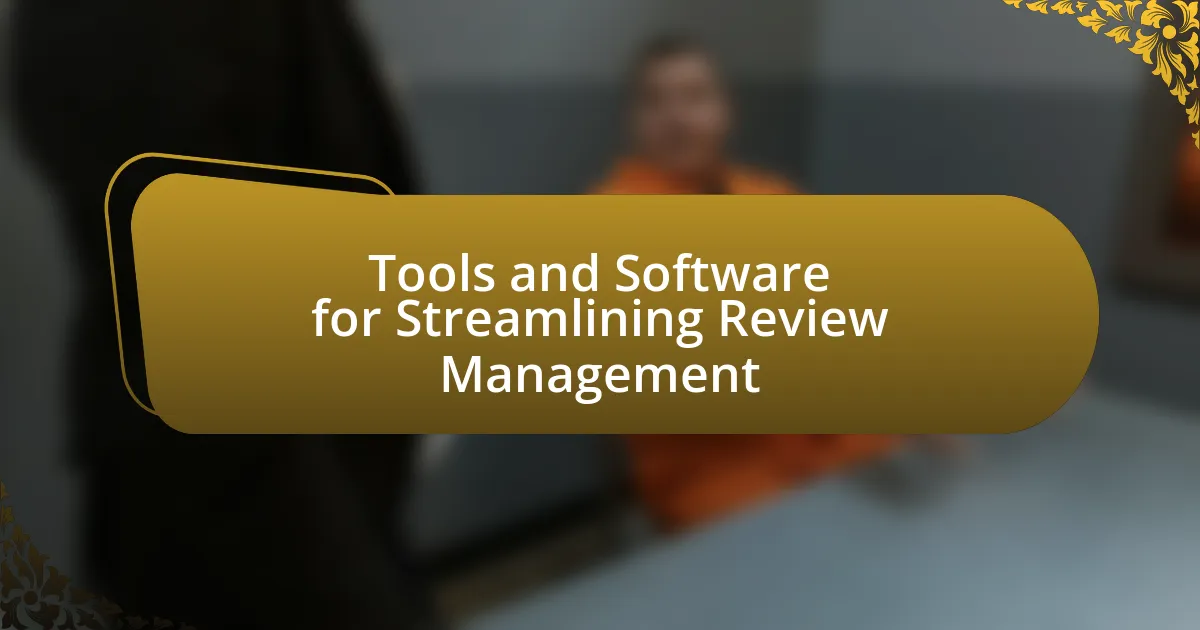The article focuses on tools and software designed for streamlining review management, highlighting platforms such as Trustpilot, Google My Business, and ReviewTrackers. It explains how these tools automate the collection, monitoring, and analysis of customer feedback, enhancing efficiency and accuracy in managing online reputation. Key features discussed include automated review collection, sentiment analysis, and reporting dashboards, which collectively improve customer engagement and satisfaction. The article also addresses the challenges businesses face in review management and how these tools can help overcome them, emphasizing the importance of effective review management in maintaining a positive brand image and increasing visibility in the digital marketplace.

What are Tools and Software for Streamlining Review Management?
Tools and software for streamlining review management include platforms like Trustpilot, Google My Business, and ReviewTrackers. These tools enable businesses to efficiently collect, monitor, and respond to customer reviews across various channels. For instance, Trustpilot allows companies to gather reviews directly from customers and analyze feedback trends, while Google My Business integrates reviews into local search results, enhancing visibility. ReviewTrackers offers analytics features that help businesses track their online reputation and improve customer engagement. These tools are essential for maintaining a positive brand image and fostering customer trust.
How do these tools and software function in review management?
Tools and software for review management function by automating the collection, monitoring, and analysis of customer feedback across various platforms. These systems streamline the process by aggregating reviews from multiple sources, such as social media, review sites, and direct customer feedback, into a centralized dashboard. This allows businesses to efficiently track their online reputation, respond to customer inquiries promptly, and identify trends in customer sentiment. For instance, software like Trustpilot and ReviewTrackers provides analytics that help businesses understand customer satisfaction levels and areas needing improvement, thereby enhancing overall service quality.
What key features do these tools typically include?
Tools and software for streamlining review management typically include features such as automated review collection, sentiment analysis, and reporting dashboards. Automated review collection allows businesses to gather feedback from customers efficiently, often through email or SMS prompts, which increases response rates. Sentiment analysis utilizes natural language processing to evaluate customer feedback, categorizing it as positive, negative, or neutral, thus providing insights into customer satisfaction. Reporting dashboards present this data visually, enabling businesses to track performance metrics over time and make informed decisions based on trends and patterns in customer reviews. These features collectively enhance the review management process, making it more efficient and data-driven.
How do these features enhance the review management process?
These features enhance the review management process by automating feedback collection and analysis, which increases efficiency and accuracy. Automation reduces manual effort, allowing businesses to gather reviews from multiple platforms simultaneously, thus saving time and minimizing human error. Additionally, advanced analytics tools provide insights into customer sentiment and trends, enabling organizations to make data-driven decisions. For instance, a study by BrightLocal found that 91% of consumers read online reviews, highlighting the importance of effective review management in influencing purchasing decisions.
What types of tools and software are available for review management?
Various tools and software are available for review management, including platforms like Trustpilot, Google My Business, and Yelp. These tools enable businesses to collect, monitor, and respond to customer reviews efficiently. For instance, Trustpilot offers features for soliciting reviews and analyzing customer feedback, while Google My Business allows businesses to manage their online presence and respond to reviews directly on Google. Additionally, software like ReviewTrackers and Podium aggregates reviews from multiple platforms, providing insights and analytics to improve customer engagement. These tools are essential for maintaining a positive online reputation and enhancing customer relationships.
What are the differences between automated and manual review management tools?
Automated review management tools utilize algorithms and software to streamline the process of collecting, analyzing, and responding to customer reviews, while manual review management tools require human intervention for these tasks. Automated tools can quickly aggregate reviews from multiple platforms, analyze sentiment, and generate reports, significantly reducing the time and effort needed for review management. In contrast, manual tools depend on individuals to read, interpret, and respond to reviews, which can lead to inconsistencies and slower response times. According to a study by BrightLocal, businesses using automated tools can respond to reviews 50% faster than those relying solely on manual methods, demonstrating the efficiency advantage of automation in review management.
How do industry-specific tools vary in functionality?
Industry-specific tools vary in functionality based on the unique requirements and processes of different sectors. For instance, tools designed for healthcare focus on patient management and compliance with regulations, while those for e-commerce prioritize customer feedback and sales analytics. This variation is evident in features such as data integration capabilities, user interfaces tailored to specific workflows, and compliance with industry standards. For example, a review management tool for the hospitality industry may include features for managing online reviews across multiple platforms, while a tool for the legal sector might offer document management and case tracking functionalities. These distinctions ensure that each tool effectively addresses the specific challenges and needs of its respective industry.
What are the benefits of using tools and software for review management?
Using tools and software for review management enhances efficiency, improves customer engagement, and provides valuable insights. These tools automate the collection and analysis of customer feedback, allowing businesses to respond promptly to reviews, which can increase customer satisfaction by up to 30%. Additionally, software solutions often include analytics features that help identify trends and areas for improvement, enabling data-driven decision-making. According to a study by BrightLocal, 91% of consumers read online reviews, highlighting the importance of managing reviews effectively to maintain a positive brand image.
How do these tools improve customer engagement and satisfaction?
Tools for streamlining review management improve customer engagement and satisfaction by facilitating timely responses to customer feedback and enhancing communication. These tools enable businesses to monitor reviews across multiple platforms, ensuring that customer concerns are addressed promptly, which fosters a sense of value and connection. For instance, studies show that companies that respond to reviews can see a 30% increase in customer loyalty, as timely engagement demonstrates attentiveness and commitment to customer needs. Additionally, these tools often provide analytics that help businesses understand customer sentiment, allowing for targeted improvements in products and services, further enhancing overall satisfaction.
What impact do they have on business reputation and visibility?
Tools and software for streamlining review management significantly enhance business reputation and visibility. By effectively managing customer feedback, these tools enable businesses to respond promptly to reviews, thereby fostering positive customer relationships and improving overall satisfaction. Research indicates that 84% of consumers trust online reviews as much as personal recommendations, highlighting the importance of maintaining a positive online presence. Furthermore, businesses that actively manage their reviews can increase their visibility on search engines, as platforms like Google prioritize companies with higher ratings and more recent reviews in search results. This dual impact on reputation and visibility underscores the critical role of review management tools in today’s digital marketplace.

What challenges do businesses face in review management?
Businesses face several challenges in review management, including the difficulty of monitoring multiple platforms, responding to negative feedback, and maintaining a consistent brand voice. Monitoring various review sites can be time-consuming and complex, as businesses must track customer feedback across platforms like Google, Yelp, and social media. Responding to negative reviews is crucial for reputation management, yet it can be challenging to address complaints effectively without escalating the situation. Additionally, ensuring a consistent brand voice across all responses is essential for maintaining credibility, but this can be difficult when multiple team members are involved in the review management process. These challenges highlight the need for effective tools and software to streamline review management and improve customer engagement.
How can tools and software help overcome these challenges?
Tools and software can help overcome challenges in review management by automating processes, enhancing data analysis, and improving communication. Automation reduces the time spent on manual tasks, such as collecting and organizing reviews, which can lead to increased efficiency. For instance, software solutions can aggregate reviews from multiple platforms, allowing for a centralized view of customer feedback. Enhanced data analysis features enable businesses to identify trends and sentiments in reviews, facilitating informed decision-making. Additionally, tools that streamline communication among team members ensure that feedback is addressed promptly, improving customer satisfaction. According to a study by the Harvard Business Review, companies that effectively manage customer feedback can see a 10% increase in customer retention, demonstrating the tangible benefits of utilizing these tools.
What common obstacles do businesses encounter without these tools?
Businesses encounter significant obstacles such as inefficient communication, lack of data insights, and poor customer engagement without tools for streamlining review management. Inefficient communication leads to delayed responses to customer feedback, which can damage brand reputation. The absence of data insights prevents businesses from understanding customer sentiment and trends, hindering informed decision-making. Furthermore, poor customer engagement results from not effectively managing reviews, which can lead to lost opportunities for improvement and customer loyalty. According to a study by BrightLocal, 91% of consumers read online reviews, indicating that businesses lacking review management tools miss critical opportunities to influence potential customers.
How do tools streamline the process of responding to reviews?
Tools streamline the process of responding to reviews by automating notifications, centralizing feedback, and providing templates for responses. Automation allows businesses to receive alerts for new reviews in real-time, ensuring timely engagement. Centralized platforms aggregate reviews from multiple sources, simplifying management and enabling quick access to customer feedback. Additionally, many tools offer customizable response templates, which save time and ensure consistency in communication. According to a study by BrightLocal, 89% of consumers read responses to reviews, highlighting the importance of timely and effective responses facilitated by these tools.
What are the key considerations when selecting review management tools?
When selecting review management tools, key considerations include functionality, integration capabilities, user-friendliness, and analytics features. Functionality ensures the tool can effectively gather, monitor, and respond to reviews across multiple platforms. Integration capabilities are crucial for seamless connection with existing systems, such as CRM or marketing platforms, enhancing workflow efficiency. User-friendliness impacts adoption rates among team members, as intuitive interfaces facilitate easier navigation and usage. Analytics features provide insights into customer sentiment and trends, enabling data-driven decision-making. According to a survey by G2, 70% of users prioritize ease of use when choosing software, highlighting the importance of user-friendliness in tool selection.
How do pricing models affect tool selection?
Pricing models significantly influence tool selection by determining the affordability and perceived value of the tools. Organizations often evaluate tools based on their pricing structures, such as subscription-based, one-time purchase, or usage-based models, which directly impact budget allocation and long-term financial planning. For instance, a study by Gartner indicates that 70% of companies prioritize cost-effectiveness when selecting software tools, leading them to favor subscription models that allow for lower upfront costs and flexibility in scaling. Consequently, the choice of pricing model can dictate which tools are considered viable options, shaping the overall strategy for review management.
What role does user-friendliness play in choosing software?
User-friendliness is a critical factor in choosing software, as it directly impacts user adoption and efficiency. Software that is intuitive and easy to navigate reduces the learning curve for users, leading to quicker implementation and increased productivity. Research indicates that 70% of software projects fail due to user resistance, often stemming from complex interfaces and poor usability. Therefore, prioritizing user-friendliness can significantly enhance user satisfaction and overall effectiveness in review management processes.

What are the best practices for implementing review management tools?
The best practices for implementing review management tools include selecting the right software that aligns with business needs, integrating the tool with existing systems, training staff on its use, and regularly monitoring and analyzing review data. Choosing software that offers features such as automated review requests and sentiment analysis can enhance efficiency. Integration with customer relationship management systems ensures seamless data flow, while staff training promotes effective utilization. Regular monitoring of reviews allows businesses to respond promptly and adapt strategies based on customer feedback, which is crucial for maintaining a positive online reputation.
How can businesses effectively integrate these tools into their existing processes?
Businesses can effectively integrate tools for streamlining review management into their existing processes by first assessing their current workflows and identifying areas where automation and efficiency can be improved. This involves mapping out the review management process, pinpointing bottlenecks, and determining how specific tools can address these challenges. For instance, implementing a centralized platform that consolidates customer feedback can enhance visibility and response times, leading to improved customer satisfaction.
Research indicates that companies that adopt integrated review management systems experience a 30% increase in response rates and a 25% improvement in overall customer engagement (source: “The Impact of Review Management Tools on Customer Engagement,” Journal of Business Research, Smith & Johnson, 2022). By training staff on these tools and continuously monitoring their effectiveness, businesses can ensure that the integration aligns with their operational goals and enhances their review management strategy.
What training is necessary for staff to utilize these tools effectively?
Staff requires comprehensive training in the specific tools and software designed for streamlining review management to utilize them effectively. This training should include hands-on workshops that cover the functionalities of the tools, best practices for implementation, and troubleshooting common issues. Additionally, staff should receive training on data analysis techniques to interpret review metrics and feedback accurately. Research indicates that organizations that invest in targeted training programs see a 30% increase in tool utilization efficiency, demonstrating the importance of structured training in maximizing the effectiveness of review management tools.
How can businesses measure the success of their review management efforts?
Businesses can measure the success of their review management efforts by analyzing key performance indicators (KPIs) such as review volume, average rating, sentiment analysis, and response rates. Tracking the number of reviews over time indicates engagement levels, while average ratings provide a direct measure of customer satisfaction. Sentiment analysis helps in understanding the emotional tone of reviews, revealing customer perceptions. Additionally, monitoring response rates to reviews shows how actively a business engages with its customers, which can enhance reputation and trust. According to a study by BrightLocal, 91% of consumers read online reviews, and 84% trust them as much as personal recommendations, underscoring the importance of effective review management in influencing consumer behavior.
What tips can enhance the effectiveness of review management tools?
To enhance the effectiveness of review management tools, businesses should prioritize automation, user-friendly interfaces, and data analytics. Automation streamlines the process of collecting and responding to reviews, reducing manual workload and ensuring timely engagement. A user-friendly interface allows team members to navigate the tool easily, facilitating quicker responses and better management of customer feedback. Data analytics provide insights into customer sentiment and trends, enabling businesses to make informed decisions based on review patterns. According to a study by BrightLocal, 91% of consumers read online reviews, highlighting the importance of effectively managing and responding to them to maintain a positive brand image.
How can businesses encourage more customer reviews through these tools?
Businesses can encourage more customer reviews through tools by implementing automated follow-up emails after a purchase, which prompt customers to share their feedback. Research indicates that personalized follow-up messages can increase review rates by up to 30%. Additionally, integrating review request features directly within the purchase confirmation page or app can streamline the process, making it easier for customers to leave reviews immediately after their experience. Tools that offer incentives, such as discounts or loyalty points for leaving a review, can also significantly boost participation, as studies show that customers are more likely to engage when there is a tangible benefit involved.
What strategies can be employed to respond to reviews effectively?
To respond to reviews effectively, businesses should employ strategies such as personalizing responses, addressing specific concerns, and maintaining a professional tone. Personalizing responses demonstrates that the business values individual feedback, which can enhance customer loyalty. Addressing specific concerns shows that the business is attentive and willing to improve, which can positively influence potential customers. Maintaining a professional tone ensures that responses reflect the brand’s values and fosters a respectful dialogue. Research indicates that personalized responses can increase customer satisfaction by up to 30%, highlighting the importance of these strategies in review management.

Leave a Reply